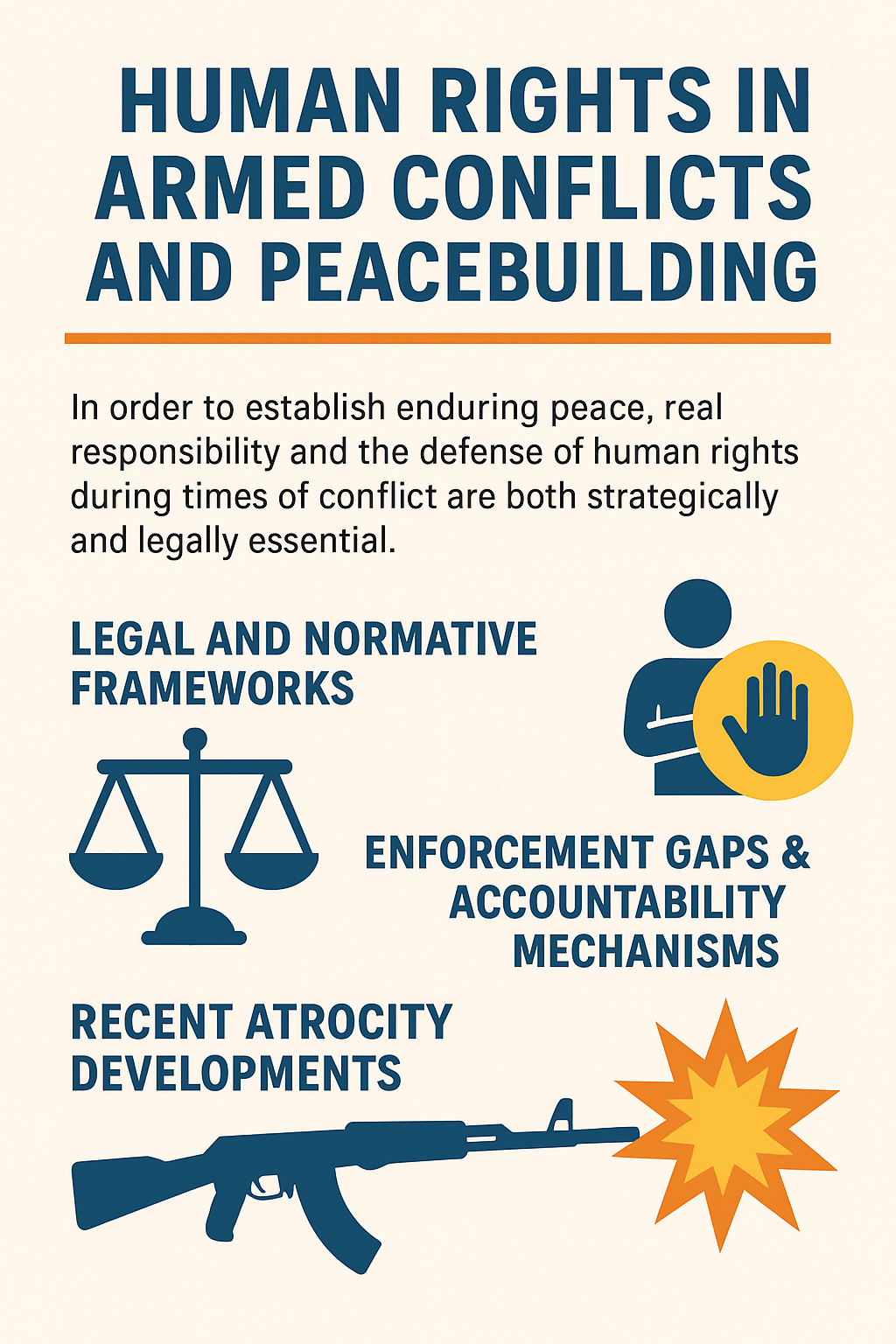View News
Human Rights in Armed Conflicts and Peacebuilding

Human Rights in Armed Conflicts and Peacebuilding: Legal Imperatives, Enforcement Challenges, and Emerging Pathways
1. Introduction
The safeguarding of human rights during armed conflicts is not merely a moral imperative but also a legal necessity under international law. For sustainable peace to emerge, there must be genuine accountability, robust enforcement of humanitarian norms, and effective peacebuilding mechanisms.
Recent global conflicts illustrate this pressing need: from the weaponization of food aid in Gaza, to mass atrocities in Darfur, to the European Court of Human Rights’ (ECHR) landmark ruling on Ukraine, and the persistent rebel-led violence in the Democratic Republic of Congo (DRC). These examples highlight both the resilience of legal frameworks and their enforcement gaps.
In modern conflicts, the pathway to transformative peace is built on the interaction of international humanitarian law (IHL), international human rights law (IHRL), transitional justice frameworks, inclusive political processes, and active civil society participation.
2. Legal and Normative Frameworks
2.1 International Humanitarian Law (IHL)
IHL, enshrined in the Geneva Conventions of 1949 and their Additional Protocols, governs the conduct of hostilities and safeguards non-combatants. Customary IHL binds all parties—state and non-state actors—and includes obligations to:
-
Prohibit torture and inhumane treatment.
-
Protect civilians and civilian objects.
-
Ensure accountability for grave breaches.
2.2 International Human Rights Law (IHRL)
IHRL remains applicable during armed conflict, complementing IHL. States and, increasingly, non-state actors are bound to uphold core rights such as:
-
The right to life.
-
The prohibition of arbitrary detention.
-
The right to due process.
2.3 Responsibility to Protect (R2P) Doctrine
Adopted at the 2005 UN World Summit, R2P rests on three pillars:
-
State Responsibility – Prevent genocide, war crimes, ethnic cleansing, and crimes against humanity.
-
International Assistance – Support states in fulfilling this responsibility.
-
Collective Action – If a state fails, the international community may act (including UN Security Council measures).
3. Enforcement Gaps and Accountability Mechanisms
3.1 Limitations in Enforcement
Despite robust laws, enforcement often falters due to:
-
Political interference and veto powers in the UN Security Council.
-
States’ reluctance to investigate their own forces.
-
Limited jurisdiction of international courts over non-member states.
The Israeli–Palestinian conflict illustrates how geopolitical interests can obstruct accountability, while ongoing violence impedes evidence gathering.
3.2 Existing Mechanisms
-
International Criminal Court (ICC) – Prosecutes genocide, crimes against humanity, and war crimes but requires state cooperation or Security Council referrals.
-
International Humanitarian Fact-Finding Commission (IHFFC) – Investigates IHL violations without prosecutorial power.
-
UN Investigative Commissions – Example: The EHRC–OHCHR investigation into Tigray.
4. Recent Atrocity Case Studies
4.1 Gaza: Weaponization of Food Aid
The UN accused Israel of using food as a weapon, possibly constituting a war crime. Reports cite over 410 deaths at aid distribution points and nearly 800 civilian deaths during attempts to access aid.
4.2 Sudan (Darfur): Continuing War Crimes
The ICC confirmed ethnic cleansing, rape, and mass killings since April 2023, with over 40,000 deaths and 13 million displaced.
4.3 Ukraine: Landmark ECHR Ruling
On 9 July 2025, the ECHR held Russia responsible for grave human rights violations, including the downing of MH17, unlawful killings, torture, and mass deportations.
4.4 Democratic Republic of Congo: Rebel Abuses
Amnesty International documented torture and enforced disappearances by Rwanda-backed M23 rebels.
5. Peacebuilding, Transitional Justice, and Reparations
5.1 Transitional Justice Mechanisms
Mechanisms include truth commissions, reparations, prosecutions, and institutional reforms.
Example: Colombia’s 2016 Peace Agreement, blending selective amnesty for political offenses with prosecution of international crimes, underpinned by UN GA Resolution 60/147.
Amnesty Guidelines:
-
Allowed for political offenses (AP II, Article 6.5).
-
Prohibited for war crimes and grave breaches.
5.2 Inclusive Peacebuilding
Research shows peace accords involving women are 35% more durable. Yet, structural, cultural, and institutional barriers often limit their participation.
6. Contemporary Challenges and Legal Innovations
6.1 Emerging Warfare Technologies
-
Drones, cyberwarfare, and AI complicate attribution and accountability.
-
Calls for new norms to criminalize ecocide and regulate remote warfare.
6.2 Civil Society’s Expanding Role
Civil society organizations:
-
Monitor and document violations.
-
Advocate for justice.
-
Drive institutional reforms.
7. Principles for Balancing Justice and Peace
An effective peace settlement requires reconciling justice with political realities:
-
Selective Amnesty – Limited to political offenses, excluding war crimes.
-
Hybrid or Mixed Tribunals – Combine domestic and international judges.
-
Comprehensive Reparations – Restitution, compensation, rehabilitation, guarantees of non-repetition.
-
Institutional Reform – Strengthen the judiciary, reform the security sector.
-
Inclusive Negotiations – Ensure participation of women, youth, victims, and marginalized groups.
-
Environmental Protection – Address wartime environmental damage in treaties.
8. Conclusion
The protection of human rights in armed conflict is not only a moral imperative but also a strategic cornerstone for sustainable peace.
From Gaza to Darfur, from Ukraine to the DRC, case law and investigative reports reveal a consistent truth: enforcement gaps undermine the credibility of legal norms.
To bridge this gap, international law must evolve—strengthening enforcement mechanisms, adapting to technological changes in warfare, and embedding inclusivity at every stage of peacebuilding. Only then can humanity move towards a global order where dignity, justice, and peace are more than aspirations—they are lived realities.
"Unlock the Potential of Legal Expertise with LegalMantra.net - Your Trusted Legal Consultancy Partner”
Disclaimer: Every effort has been made to avoid errors or omissions in this material in spite of this, errors may creep in. Any mistake, error or discrepancy noted may be brought to our notice which shall be taken care of in the next edition In no event the author shall be liable for any direct indirect, special or incidental damage resulting from or arising out of or in connection with the use of this information Many sources have been considered including Newspapers, Journals, Bare Acts, Case Materials , Charted Secretary, Research Papers etc
-Prerna Yadav
LegalMantra.net Team

